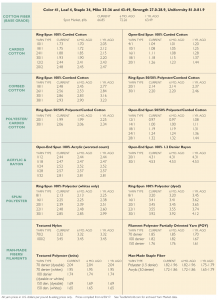 By Jim Phillips, Yarn Market Editor
By Jim Phillips, Yarn Market Editor
Spinners and industry insiders interviewed by Yarn Market say they are optimistic that the improved results of the past few months will continue through the third quarter of the year.
“I would say I feel good about where we are and how the next few months look,” said one multi-national spinner. “We are getting good week-to-week results, but we haven’t yet built a substantial backlog.” He maintains an inventory correction is still in progress with a number of major customers. “We knew there was an excess of inventory; we just didn’t realize how big it was.
I believe some major customers still have inventory they need to move. Once that happens, I believe we will start to see bigger orders come in. That will create some longer-range opportunities.”
Another spinner commented: “Many ring-spun yarns are still in demand. Blends are still moving well. I’ve seen some improvement in 100-percent combed cotton yarns. OE products are still sluggish, and a lot of that is because the market is currently oversupplied.”
From a yarn broker: “Specialty yarns are strong — but they’ve been pretty solid all along. I’ve seen some improvement in size of orders, as well. Overall, I am happy with where we are at the moment, but there is still room for improvement. I hope — and believe — that business conditions will continue to improve for us as the year progresses.”
Opportunities For Growth
Several spinners are seeing niche products as an opportunity for growth. “One of the things that works in our favor is our research and development capabilities,” said one spinner. “We have developed a reputation as an innovator, and we have customers coming to us asking for us to help develop a yarn that fills a specific need.”
Another spinner commented: “There are a lot of opportunities out there for development of yarns for technical and specialty applications. We have been working to further develop better fire-retardant products, for example. And there are new opportunities every day for new high-technology applications.”
The demand for advanced products is one of the reasons for the resurgence of the U.S. textile industry, sources say. As a result, textile colleges and schools are once again turning out high numbers of graduates. For example, a late June news release from the American Chemical Society read in part: “… the high-tech nature of modern textiles and a drive for productivity has increased the demand for experts, including polymer chemists and dye specialists. For example, the North Carolina State University College of Textiles reported its largest-ever graduating class this year. And if the past is any indication, most are likely to find jobs within three months of earning their degrees. In a field once marked by rampant job loss, stability is returning with a new focus on advanced specialty products.”
Beyond high-tech applications, rising wages in China and other countries, along with higher infrastructure costs, have resulted in numerous programs returning to the Western Hemisphere. “Our industry is the most technically advanced in the world,” said one industry expert. “Productivity and efficiency enables us to be competitive even with low-wage countries. And our industry is unmatched in product quality, delivery and service. There are going to be bumps in the road from time to time, but I think the future for U.S. textiles is bright and that you will continue to see growth.”
Added another spinner: “Barring some unforeseen upheaval, our industry is healthier today than it has been in many years. More and more customers are realizing the advantages that can be had by placing programs with U.S. companies.”
Cotton Prices
For the week ending June 29, the price for the base quality of cotton (color 41, leaf 4, staple 34, mike 35-36 and 43-49, strength 27.0-28.9, uniformity 81.0-81.9) in the seven designated markets measured by the USDA averaged 66.85 cents per pound. This is the lowest weekly average since August 19, 2016, when the average was 66.94 cents. The weekly average was down from 66.99 the previous week, but up from 63.44 cents reported the corresponding period a year ago. The ICE October settlement prices ended the week at 69.05 cents, compared to 68.03 cents the previous week.
July/August 2017





